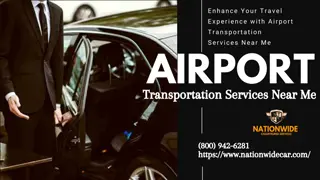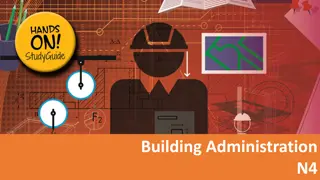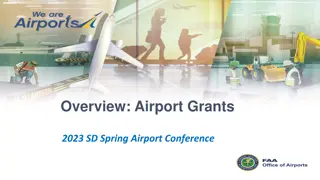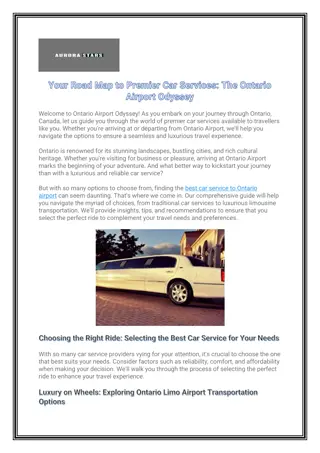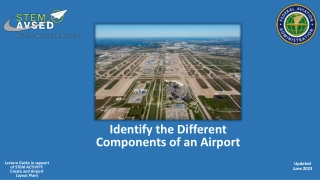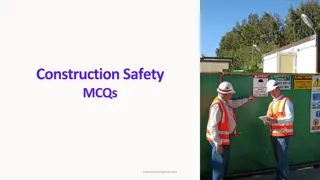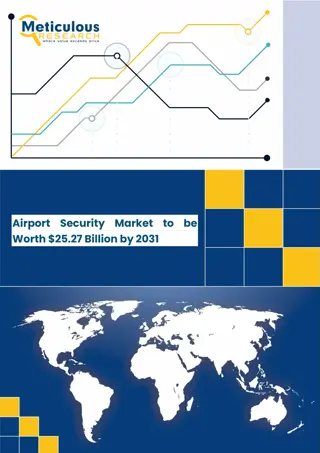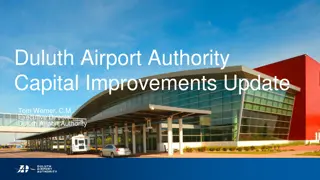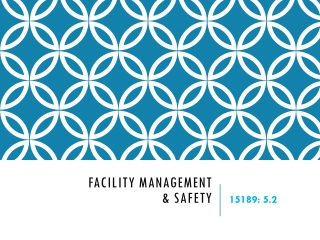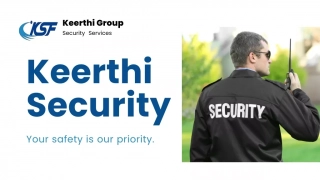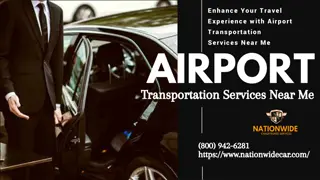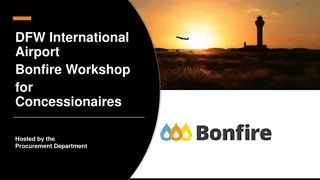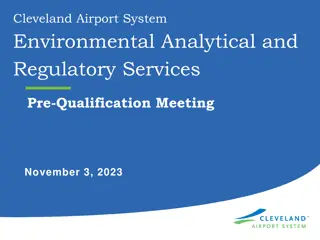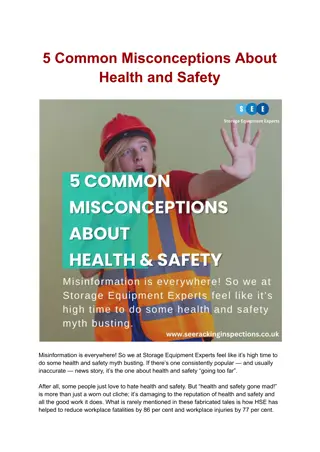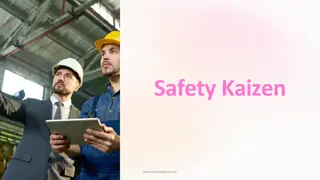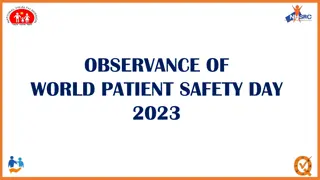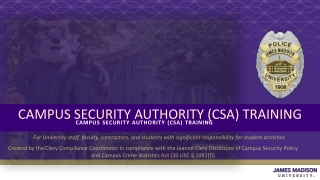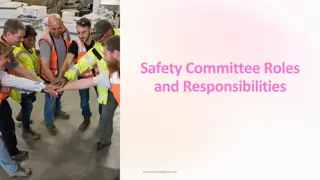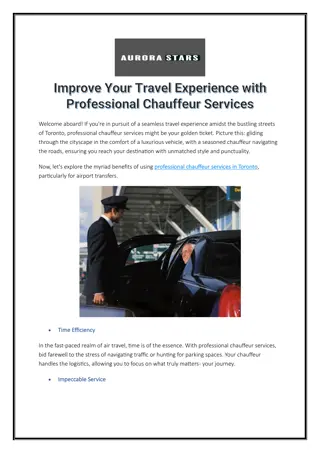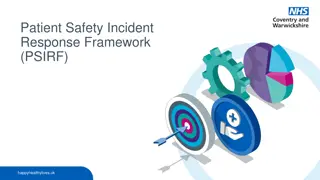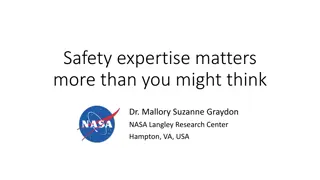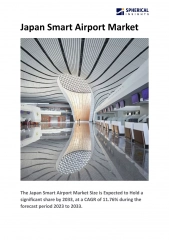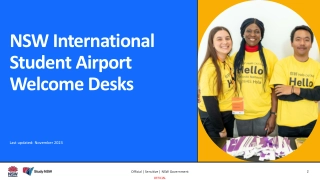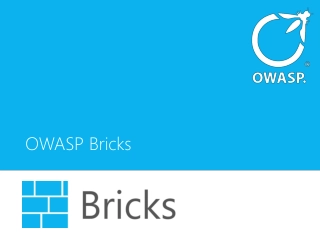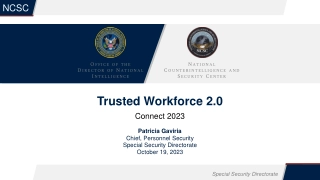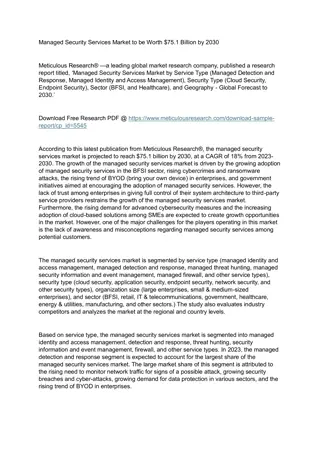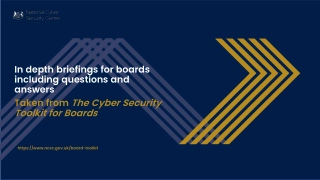Airport Safety and Security Case Study: Rehabilitating Taxiway M during Construction
Exploring the rehabilitation of Taxiway M at an airport with a focus on safety and security during construction. The project involves a panel of experts, project team details, outlines key aspects such as scope, safety risk management, reasons for conducting it, and the current safety systems. The importance of safety risk management is highlighted along with steps involved in the process.
Airport Safety and Security Case Study: Rehabilitating Taxiway M during Construction
PowerPoint presentation about 'Airport Safety and Security Case Study: Rehabilitating Taxiway M during Construction'. This presentation describes the topic on Exploring the rehabilitation of Taxiway M at an airport with a focus on safety and security during construction. The project involves a panel of experts, project team details, outlines key aspects such as scope, safety risk management, reasons for conducting it, and the current safety systems. The importance of safety risk management is highlighted along with steps involved in the process.. Download this presentation absolutely free.
Presentation Transcript
REHABILITATE TAXIWAY M: A CASE STUDY AIRPORT SAFETY AND SECURITY DURING CONSTRUCTION 2019 UNCC / CLT Fall Aviation Engineering On-Site Seminar
Panelists Tracy Saunders, P.E., C.M., Delta Airport Consultants, Inc. Terry Page, P.E., Delta Airport Consultants, Inc. Scott O Halloran, FAA CLT ATCT Support Specialist Jeff Perry, C.M., ACE, Airside Operations Manager, CLT Brian McMahan, C.M., ACE, Construction Manager, Talbert, Bright & Ellington
Project Team Owner: City of Charlotte, Aviation Department Construction Manager: Talbert, Bright & Ellington Contractor: Hi-Way Paving, Inc. Engineer: Delta Airport Consultants, Inc.
Outline 1. 2. 3. 4. 5. 6. Scope of Project Safety Risk Management Project Phasing FAA / ATC Airside Operations Development / Construction
Scope of Project Tracy Saunders, P.E., C.M., Delta Airport Consultants, Inc.
Safety Risk Management Terry Page, P.E. Delta Airport Consultants, Inc.
Why Conduct Safety Risk Management? a. b. Identifies Potential Hazards Before Project Starts c. Discuss Potential Design Changes to Avoid Risks (Rather than CO s) d. Enhances Airport Safety for Airlines and Contractor e. Satisfies requirements of FAA Order 5200.11 f. Protects the Airport Owner* Provides a forum to brief all stakeholders on the project (* Consult an attorney on this one)
Safety Risk Management: The Steps a. b. Define and Describe the Project c. Identify Preliminary List of Potential Hazards d. Analyze and Assess Risks with a Matrix e. Develop Hazard Mitigation Plan f. Incorporate into Project Phasing / Design Convene Safety Assessment Panel of Experts
Safety Risk Management: CLT Taxiway M a. b. Assessed where hazards could result in unacceptable risks c. Identified realistic mitigation measures d. Re-assessed risk level with mitigation in place e. Provided guidance to project engineers to revise plans f. Documented the results of the Workshop Workshop panel identified potential credible hazards
CLT Taxiway M SRM Workshop Participants Rick Tanfero, CLT Lexie Farmer, CLT Jeffrey Perry, CLT James H. Wally, CLT Jeff McSwain, CLT Ashton Watson, CLT Brian McMahan, CLT Bernie Davis, American Airlines Mike Bryant, American Airlines Lori Cline, American Airlines Kenneth Moody, Delta Airport Cons. Tracy Saunders, Delta Airport Cons. Sierra Heaton, Delta Airport Cons. Terry Page, Delta Airport Cons. Kate DeJarnette, Delta Airport Con. Adam White, FAA CLT ATCT Scott O Halloran, FAA CLT ATCT
Safety Risk Management: Taxiway M Results Stakeholders were made aware of the project work areas, impacts and schedule b. The construction phasing layout was revised to separate construction vehicles further from aircraft c. The construction phasing reduced the number of flaggers needed d. Overall, we believe aircraft efficiency and safety were enhanced a.
Safety Risk Management: Resources Consider Using FAA s Hazard Assessment Tools: FAA Order 5200.11, Safety Management Systems https://www.faa.gov/airports/airport_safety/safety_management_ systems/ Office of Airports, FAA SMS Desk Reference contains Safety Assessment process guidance along with a sample and blank templates
Project Phasing Tracy Saunders, P.E., C.M., Delta Airport Consultants, Inc.
Overall Project Phasing Phasing Philosophy Complete haul route / gate construction, then pave out to the south. Base Bid 180 Calendar Days Liquidated Damages: $10,000 per calendar day will be assessed against the Contractor for each calendar day or portion thereof that the total contract time is exceeded. $2,500 per calendar day will be assessed against the Contractor for each calendar day or portion thereof that specific milestones are exceeded.
CLT FAA / ATCT Surface Team Scott O Halloran, FAA CLT ATCT Support Specialist
Mission / Efforts Established in 2012, the mission of the CLT Surface Team is to enhance the safety and efficiency of the Charlotte Douglas International Airport. Our efforts include designing new traffic flows to reduce delays associated with limited ramp space, identifying and mitigating ramp congestion, identifying strategic places to hold delayed airport, and to coordinate upcoming construction projects and temporary closures with airport personnel and stakeholders.
Makeup Members FAA 2 National Air Traffic Controllers Association (NATCA) and 2 Management Industry Dedicated Support: Subject Matter Expert (SME) as requested Support Staff specialist, Traffic Management Coordinator (TMC) and Operations Manager (OM) Airport Operations FAA Tech Ops
Secret to Surface Team Success a. b. Transparency c. Open-minded d. FAA Team Members have equal authority and have approval rights for Surface Team e. AA Ramp Tower collaboration with FAA Surface Team f. Recognize and learn from partial successes g. Initiate lessons learned discussion / process Collaboration
Rehabilitate Taxiway M Collaboration a. b. Identified risks with preliminary construction haul route and potential for FOD c. Final solution mitigated and reduced risk to both aircraft and construction personnel d. Potential for FOD area was also greatly reduced Participation in Safety Risk Management Workshop
Rehabilitate Taxiway M Collaboration Originally Proposed Haul Route
Rehabilitate Taxiway M Collaboration Final Haul Route
Takeaways The future success of our aviation industry requires a shared endeavor We are a Team b. ATC should be viewed as a partner of the system users a.
Airside Operations / Security Jeff Perry, C.M., ACE, Airside Operations Manager, CLT
Airside Operations / Security a. b. Marked Haul Route with Flaggers c. CLT Operations Officer at Runway 5-23 / Taxiway A Crossing d. Liaison between CLT Operations / CLT Development e. Weekly Construction Meetings / Communication Single Access Point with Security by CLT
Development / Construction Brian McMahan, C.M., ACE, Construction Manager, Talbert, Bright and Ellington
Construction Team Owner: City of Charlotte, Aviation Department Construction Manager: Talbert, Bright & Ellington
City of Charlotte, Aviation Department James Wally, P.E., Engineering Program Manager Shane Nixon, Engineering Project Manager Hunter Ballard, Lead Project Inspector Cody Smith, Lead Chief Airport Inspector Ryan Fairchild, Chief Airport Inspector Jeff Perry, C.M., ACE, Airside Operations Manager Matt Freeman, Airport Ops Supervisor II
Talbert, Bright & Ellington Brian McMahan, C.M., ACE, Construction Manager Danny Jones, Resident Project Representative Kyle Clark, Resident Project Representative
Development / Construction a. b. Weekly Construction Meetings / Communication c. Schedule Updates to FAA ATC / CLT Partners (airlines) d. Coordination with other CLT Departments (Operations, Maintenance) e. Interface / Impact to other CLT Projects Phased Construction / Multiple Work Areas
Work Area B Phasing Work Area B: Taxiway M at Taxiway B 10 Calendar Days Work Area B-1: Temporary Haul Route Construction 10 Calendar Days Nightly From 11:00 P.M. to 5:30 A.M.
Work Area C Phasing Work Area C: Taxiway F between Taxiway M and Ramp 50 Calendar Days Work Area C-1: Taxiway F between Taxiway M and Ramp (Inside Taxiway E TOFA) 14 Calendar Days/Work Periods Nightly From 11:00 P.M. to 5:30 A.M.
Work Area D Phasing Work Area D: Taxiway M / Taxiway F Intersection 100 Calendar Days Work Area D-1: Taxiway M / Taxiway F Intersection (Inside Taxiway E TOFA) 14 Calendar Days/Work Periods Nightly From 11:00 P.M. to 5:30 A.M.
Work Area E Phasing Taxiway M West 80 Calendar Days


